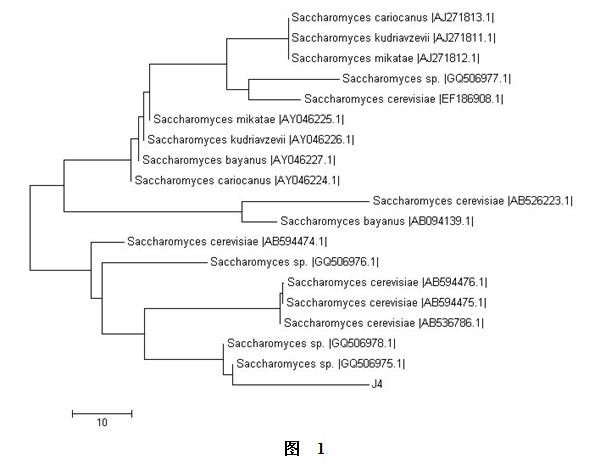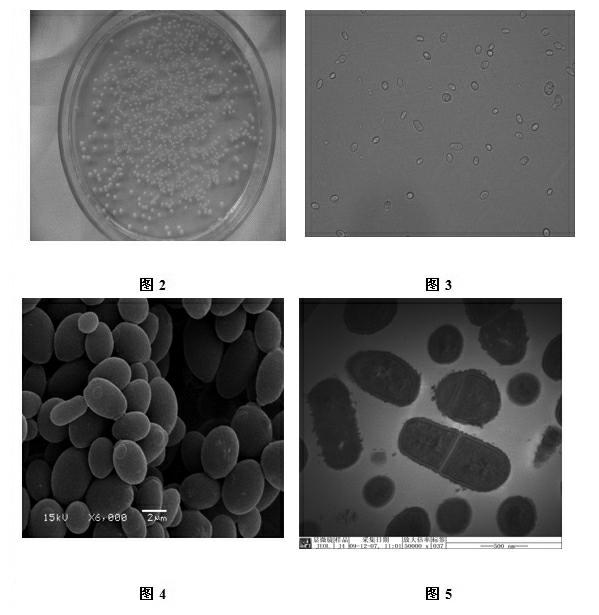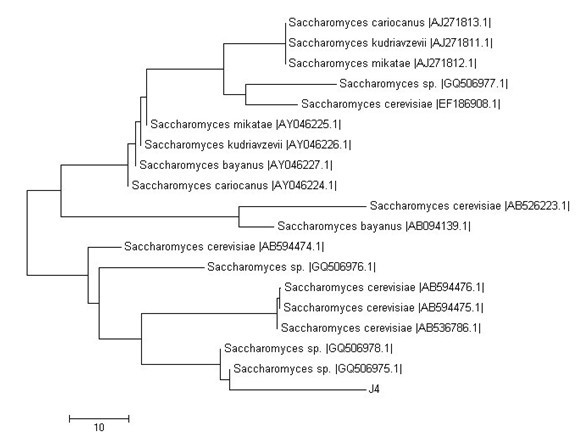New strain J4 for biofermentation of fruit wine and application thereof
A technology of biological fermentation and new strains, applied in the direction of microorganisms, microorganism-based methods, biochemical equipment and methods, etc., can solve the problems of strict nutritional requirements, unstable calcium salt precipitation, limited acid reduction of lactic acid bacteria, etc. The effect of softening and improving the quality of fruit wine
- Summary
- Abstract
- Description
- Claims
- Application Information
AI Technical Summary
Problems solved by technology
Method used
Image
Examples
Embodiment 1
[0016] The microbiological characteristics, such as morphology, physiology and biochemistry, 18S rDNA sequence determination and homology analysis of the new fruit wine biological fermentation strain Saccharomyces cerevisiae J4 of the present invention will be introduced below with reference to the accompanying drawings.
[0017] Isolation and Breeding of Saccharomyces cerevisiae J4
[0018] 1. Isolation of yeast strains
[0019] Using fresh thorn grapes as raw materials, the thorn grape pulp is made through selection, cleaning, crushing and other processes, and the total SO of the pulp is adjusted. 2 The concentration is 80mg / L, and it is divided into 5L fermenters and fermented naturally at 20-25°C as a source of yeast selection.
[0020] When the sample has a lot of air bubbles in the fermenter, take 10% of the fermentation liquid and put it into the yeast enrichment medium, and incubate at 28°C for 1 day. Under aseptic conditions, carry out 10-fold gradient dilution of...
Embodiment 2
[0041] Embodiment 2: the application of Saccharomyces cerevisiae J4 in the brewing of " Jiefangzhong " loquat wine
[0042] After activation of Saccharomyces cerevisiae J4 in the seed fermentation medium, 4.3×10 7 The inoculum was added to "Jiefangzhong" loquat pulp with a pH value of 3.05 and an initial total acidity of 7.6 g / L at 80 mg / L, and fermented at 23±1°C for 10 days. The fermentation capacity was investigated, and the results are shown in Tables 2 and 3. Saccharomyces cerevisiae J4 can degrade malic acid and citric acid, which are more irritating, and produce lactic acid with softer sourness. 0.8g / L, the wine has pure flavor, soft taste and mellow wine aroma. It can be seen that Saccharomyces cerevisiae J4 is a yeast strain with acid metabolism ability and excellent comprehensive performance, which is suitable for the production of "Jiefangzhong" loquat wine.
[0043] Table 2 Changes of main physical and chemical indicators of "Jiefangzhong" loquat wine before a...
Embodiment 3
[0047] Embodiment 3: the application of saccharomyces cerevisiae J4 in " Kyoho " wine
[0048] After Saccharomyces cerevisiae J4 was activated in the seed fermentation medium, the total sulfur concentration and pH value of the grape pulp were adjusted according to the orthogonal test scheme in Table 4 and inoculated, and fermented at 25±1°C for 5-20 days. The fermentation ability of Saccharomyces cerevisiae J4 was investigated, and the results are shown in Table 5. The results show that the average alcohol content of the "Kyoho" grape wine brewed with Saccharomyces cerevisiae J4 is 13.2%, the total acid is 0.7~1.0g / L lower than the grape puree, and the residual sugar content is lower than 0.4%. Soft, mellow bouquet. It can be seen that Saccharomyces cerevisiae J4 is a yeast strain with acid metabolism ability and excellent comprehensive performance, which is suitable for the production of "Kyoho" wine.
[0049] Table 4 Orthogonal test L 9 (3 4 ) factor level table
[00...
PUM
 Login to View More
Login to View More Abstract
Description
Claims
Application Information
 Login to View More
Login to View More - R&D
- Intellectual Property
- Life Sciences
- Materials
- Tech Scout
- Unparalleled Data Quality
- Higher Quality Content
- 60% Fewer Hallucinations
Browse by: Latest US Patents, China's latest patents, Technical Efficacy Thesaurus, Application Domain, Technology Topic, Popular Technical Reports.
© 2025 PatSnap. All rights reserved.Legal|Privacy policy|Modern Slavery Act Transparency Statement|Sitemap|About US| Contact US: help@patsnap.com



